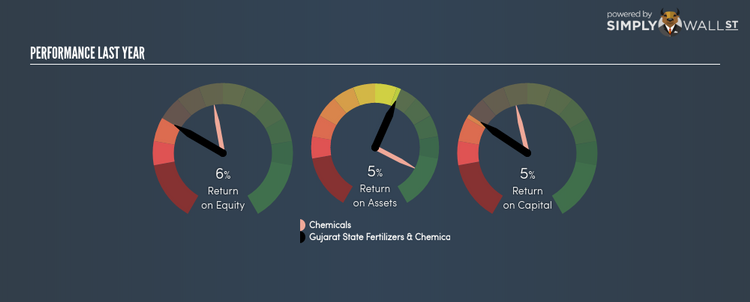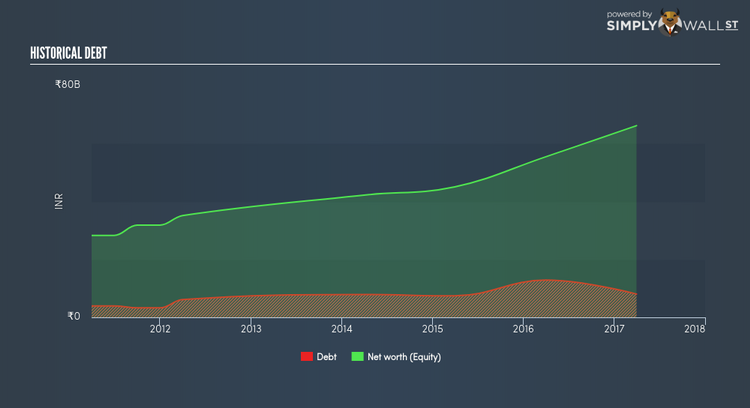What You Must Know About Gujarat State Fertilizers & Chemicals Limited’s (NSE:GSFC) Return on Equity

Gujarat State Fertilizers & Chemicals Limited (NSEI:GSFC) delivered a less impressive 6.41% ROE over the past year, compared to the 14.36% return generated by its industry. An investor may attribute an inferior ROE to a relatively inefficient performance, and whilst this can often be the case, knowing the nuts and bolts of the ROE calculation may change that perspective and give you a deeper insight into GSFC’s past performance. Today I will look at how components such as financial leverage can influence ROE which may impact the sustainability of GSFC’s returns. View our latest analysis for Gujarat State Fertilizers & Chemicals
Breaking down ROE — the mother of all ratios
Firstly, Return on Equity, or ROE, is simply the percentage of last years’ earning against the book value of shareholders’ equity. It essentially shows how much the company can generate in earnings given the amount of equity it has raised. Generally speaking, a higher ROE is preferred; however, there are other factors we must also consider before making any conclusions.
Return on Equity = Net Profit ÷ Shareholders Equity
Returns are usually compared to costs to measure the efficiency of capital. Gujarat State Fertilizers & Chemicals’s cost of equity is 13.40%. This means Gujarat State Fertilizers & Chemicals’s returns actually do not cover its own cost of equity, with a discrepancy of -6.99%. This isn’t sustainable as it implies, very simply, that the company pays more for its capital than what it generates in return. ROE can be broken down into three different ratios: net profit margin, asset turnover, and financial leverage. This is called the Dupont Formula:
Dupont Formula
ROE = profit margin × asset turnover × financial leverage
ROE = (annual net profit ÷ sales) × (sales ÷ assets) × (assets ÷ shareholders’ equity)
ROE = annual net profit ÷ shareholders’ equity
Essentially, profit margin shows how much money the company makes after paying for all its expenses. Asset turnover reveals how much revenue can be generated from Gujarat State Fertilizers & Chemicals’s asset base. And finally, financial leverage is simply how much of assets are funded by equity, which exhibits how sustainable the company’s capital structure is. Since ROE can be inflated by excessive debt, we need to examine Gujarat State Fertilizers & Chemicals’s debt-to-equity level. The debt-to-equity ratio currently stands at a low 12.17%, meaning Gujarat State Fertilizers & Chemicals still has headroom to borrow debt to increase profits.
Next Steps:
ROE is a simple yet informative ratio, illustrating the various components that each measure the quality of the overall stock. Gujarat State Fertilizers & Chemicals’s ROE is underwhelming relative to the industry average, and its returns were also not strong enough to cover its own cost of equity. Although, its appropriate level of leverage means investors can be more confident in the sustainability of Gujarat State Fertilizers & Chemicals’s return with a possible increase should the company decide to increase its debt levels. ROE is a helpful signal, but it is definitely not sufficient on its own to make an investment decision.
For Gujarat State Fertilizers & Chemicals, I’ve compiled three fundamental aspects you should look at:
1. Financial Health: Does it have a healthy balance sheet? Take a look at our free balance sheet analysis with six simple checks on key factors like leverage and risk.
2. Valuation: What is Gujarat State Fertilizers & Chemicals worth today? Is the stock undervalued, even when its growth outlook is factored into its intrinsic value? The intrinsic value infographic in our free research report helps visualize whether Gujarat State Fertilizers & Chemicals is currently mispriced by the market.
3. Other High-Growth Alternatives : Are there other high-growth stocks you could be holding instead of Gujarat State Fertilizers & Chemicals? Explore our interactive list of stocks with large growth potential to get an idea of what else is out there you may be missing!
To help readers see pass the short term volatility of the financial market, we aim to bring you a long-term focused research analysis purely driven by fundamental data. Note that our analysis does not factor in the latest price sensitive company announcements.
The author is an independent contributor and at the time of publication had no position in the stocks mentioned.


